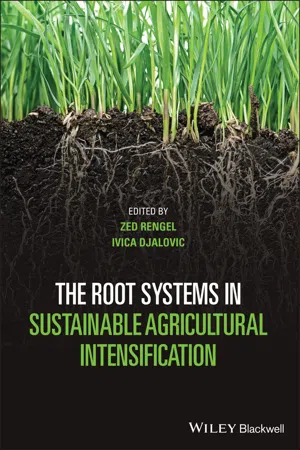
The Root Systems in Sustainable Agricultural Intensification
- English
- ePUB (mobile friendly)
- Available on iOS & Android
The Root Systems in Sustainable Agricultural Intensification
About this book
Explore an in-depth and insightful collection of resources discussing various aspects of root structure and function in intensive agricultural systems
The Root Systems in Sustainable Agricultural Intensification delivers a comprehensive treatment of state-of-the-art concepts in the theoretical and practical aspects of agricultural management to enhance root system architecture and function. The book emphasizes the agricultural measures that enhance root capacity to develop and function under a range of water and nutrient regimes to maximize food, feed, and fibre production, as well as minimize undesirable water and nutrient losses to the environment.
This reference includes resources that discuss a variety of soil, plant, agronomy, farming system, breeding, molecular and modelling aspects to the subject. It also discusses strategies and mechanisms that underpin increased water- and nutrient-use efficiency and combines consideration of natural and agricultural systems to show the continuity of traits and mechanisms.
Finally, the book explores issues related to the global economy as well as widespread social issues that arise from, or are underpinned by, agricultural intensification. Readers will also benefit from the inclusion of:
- A thorough introduction to sustainable intensification, including its meaning, the need for the technology, components, and the role of root systems
- Exploration of the dynamics of root systems in crop and pasture genotypes over the last 100 years
- Discussion of the interplay between root structure and function with soil microbiome in enhancing efficiency of nitrogen and phosphorus acquisition
- Evaluation of water uptake in drying soil, including balancing supply and demand
Perfect for agronomists, horticulturalists, plant and soil scientists, breeders, and soil microbiologists, The Root Systems in Sustainable Agricultural Intensification will also earn a place in the libraries of advanced undergraduate and postgraduate students in this field who seek a one-stop reference in the area of root structure and function.
Frequently asked questions
- Essential is ideal for learners and professionals who enjoy exploring a wide range of subjects. Access the Essential Library with 800,000+ trusted titles and best-sellers across business, personal growth, and the humanities. Includes unlimited reading time and Standard Read Aloud voice.
- Complete: Perfect for advanced learners and researchers needing full, unrestricted access. Unlock 1.4M+ books across hundreds of subjects, including academic and specialized titles. The Complete Plan also includes advanced features like Premium Read Aloud and Research Assistant.
Please note we cannot support devices running on iOS 13 and Android 7 or earlier. Learn more about using the app.
Information
1
Sustainable Intensification: Meaning, Need, Components, and Role of Root Systems
1.1 Introduction
Table of contents
- Cover
- Table of Contents
- Title Page
- Copyright Page
- List of Contributors
- Preface
- 1 Sustainable Intensification
- 2 Genetic and Molecular Regulation of Root Growth and Development
- 3 Plant Roots for Sustainable Soil Structure Management in Cropping Systems
- 4 Dynamics of Root Systems in Crop and Pasture Genotypes over the Last 100 Years
- 5 Interplay Between Root Structure and Function in Enhancing Efficiency of Nitrogen and Phosphorus Acquisition
- 6 Root–microbe Interactions Influencing Water and Nutrient Acquisition Efficiency
- 7 The Interplay Between Roots and Arbuscular Mycorrhizal Fungi Influencing Water and Nutrient Acquisition and Use Efficiency
- 8 Role of Seed Priming in Root Development and Crop Production
- 9 Water Uptake in Drying Soil
- 10 Winter Wheat and Summer Maize Roots in Agro‐Ecosystems on the North China Plain
- 11 Intercropping to Maximize Root–Root Interactions in Agricultural Plants
- 12 Intercropping to Maximize Root–Root Interactions in Agricultural Plants
- 13 The 3‐D Imaging of Roots Growing in Soil
- 14 Simulating the Diversity and Plasticity of Root Systems Using 3D Models of the Root System Architecture
- 15 Phenotyping‐Modelling Interfaces to Advance Breeding for Optimized Crop Root Systems
- Index
- End User License Agreement